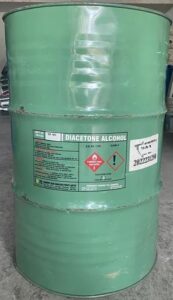Di Acetone Alcohol Liquid
Product Description
Di Acetone Alcohol (DAA) is a colorless, volatile liquid with a sweet, fruity odor. It is a type of ketone and is known for its excellent solvent properties. DAA is commonly used in various industrial applications, including coatings, adhesives, and as a solvent in chemical processes. Its ability to dissolve a wide range of organic compounds makes it a valuable ingredient in many formulations.
Uses
- Solvent: DAA is widely used as a solvent in paints, coatings, and adhesives due to its ability to dissolve a variety of substances.
- Chemical Intermediate: It serves as an intermediate in the synthesis of other chemicals, including pharmaceuticals and agrochemicals.
- Cleaning Agent: DAA is effective in cleaning applications, particularly for removing grease and oils.
- Cosmetic Formulations: It is used in some cosmetic products for its solvent properties and ability to enhance product stability.
- Laboratory Reagent: DAA is utilized in laboratories for various chemical reactions and analyses.
Technical Data
| Property | Value |
|---|---|
| Chemical Formula | C₁₀H₁₄O₃ |
| Molecular Weight | 174.22 g/mol |
| Appearance | Colorless liquid |
| Odor | Sweet, fruity |
| Boiling Point | 164 °C (327 °F) |
| Melting Point | -20 °C (-4 °F) |
| Density | 0.93 g/cm³ |
| Flash Point | 54 °C (129 °F) |
| Solubility in Water | Slightly soluble |
| Viscosity | 1.2 mPa·s at 20 °C |
| Vapor Pressure | 0.5 mmHg at 20 °C |
| Safety Data Sheet (SDS) | Available upon request |
Key Features
- High Solvency Power: DAA can dissolve a wide range of organic materials, making it ideal for various applications.
- Low Toxicity: Compared to other solvents, DAA has a relatively low toxicity profile, making it safer for use in many environments.
- Versatile Applications: Its diverse range of uses across different industries highlights its importance as a chemical solvent and intermediate.
Conclusion
Di Acetone Alcohol is a versatile and effective solvent with a wide range of applications in various industries. Its unique properties make it an essential component in formulations for coatings, adhesives, and cleaning agents. Understanding its technical data and uses can help industries leverage its benefits effectively.

